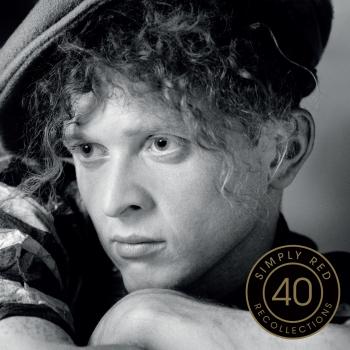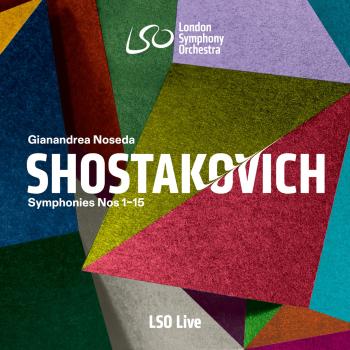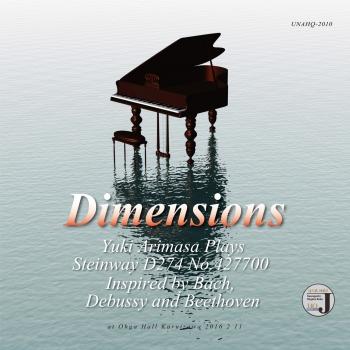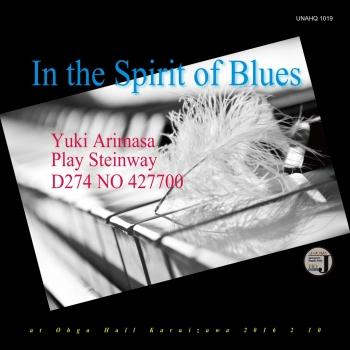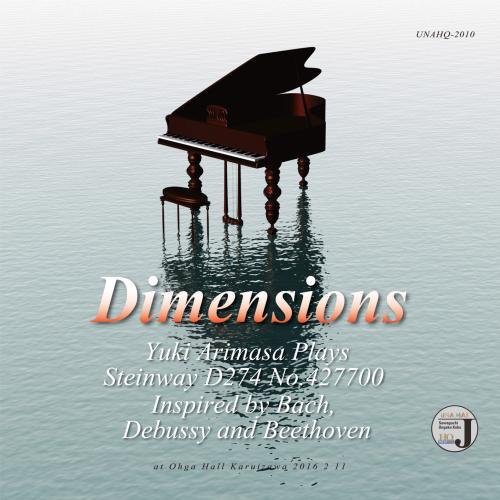
Dimensions (Works by Bach, Debussy, Beethoven) Yuki Arimasa
Album info
Album-Release:
2016
HRA-Release:
12.12.2016
Album including Album cover
- 1 Inspirations: Bach Cantata BWV 147 11:14
- 2 Inspirations: Bach Partita BWV 826 Sarabande Part1 02:51
- 3 Inspirations: Bach Partita BWV 826 Sarabande Part2 02:39
- 4 Inspirations: Bach Partita BWV 826 Sarabande Part3 02:56
- 5 Inspirations: Debussy Homage to Rameau 14:24
- 6 Inspirations: Beethoven Piano Sonata No.8 Op.13 - Adagio 05:07
- 7 Green Sleeves 06:08
Info for Dimensions (Works by Bach, Debussy, Beethoven)
“Dimensions” by Yuki Arimasa appears in UNAMAS Classic Series. The previous release in the Series include Vivaldi’s Four Seasons in a radical arrangement; Bach’s Art of Fugue winning Japan Professional Music Recording Award; and Schubert’s Death and the Maiden that rocks.
The fourth release if the first solo piano album in the Series, and the session was recorded in February 2016 in Ohga Hall, Karuizawa achieving the ultimate sound quality using the latest technology and equipment, integrating advanced ideas into fundamental policies of Technology/Engineering/Art multi-dimensionally that brings incomparably unique picture in the listening.
Yuki has a distinguished career as jazz pianist such as years of experience as assistant professor in Berklee College of Music, and he already appeared in some released albums from UNAMAS. This album enjoys the jazz flavor the most because well-known classical themes are improvised in the style of jazz.
J. S. Bach’s Cantata No.147, Debussy’s Homage à Rameau, Beethoven’s piano sonata No.8 and others radically transform via Yuki’s unique improvisation.
Class-of-the-art technology, equipment and performance all combined, you will enjoy not only the excellent performance but also the highest sound quality. Purely clear high notes and the exceptional beautify of piano envelope in subtle decays are such particular examples thanks to high-res.
„I have never heard such a sound from recorded media that realizes the image of piano itself almost visible. It is as if the listening touches the instrument through the ears. What makes the sound so real? One of factors I perceive is the purity without least residues in the notes that builds up the form of instrument. Particularly noticeable is the beauty in the extremely fine and subtle decay of envelopes.
The piano played here is Steinway Hamburg D274 model, and its serial number #427700 implies that the instrument came with Arturo Benedetti Michelangeli when he visited Japan. As he went back home before his scheduled final concert, the artist being infamous for such behaviors, the inviter-agent kept hold of his instrument instead and then later offered it to Ohga Hall through some kind of relationship. The pitch is tuned at 440Hz “classically” in the recording as Yuki Arimasa specified.
The music here, the collection of ballades, is actually all derived from well-known themes of classical music, and Yuki Arimasa expands his improvisation as we enjoy the progress crossing the border of classical and jazz music.“
Track 5 is “Homage à Rameau”, one of three pieces in Debussy’s “Image 1”. Debussy was very much into the methodology of classical and baroque compositions in this period of time. As an implication for it, some of his works were actually titled “Prelude” or “Sarabande”, and Rameau, the French major in 17th century, seemed his particular favor. I tend to find this piece is the core of this album, and Yuki showed much concentration in it as his homage to Debussy.
Back to the earlier topic of sound purity, Mick confessed, “it may be perhaps due to the benefit of batteries”. In Ohga Hall in Karuizawa where the recording took place, the entire electric energy was supplied from a couple of portable battery products “Power Yiile Plus” that were brought in specifically for this session. The product is nominally for home use in the emergency power-down occasions or for shifting peak consumption time, while it can sufficiently serve 7-8 hours of the recording session like this. If one would use the same solution in the playing at home, the result might be even more astounding! One more factor to note in addition would be the perfectionistic treatment of all kinds of vibrations around the stage even for each contact of cables and plugs that is now the style of UNAMAS recording sessions.
I listened to this recording first in the 9.1 mix that set a standard in my brain and ears. At a later time, I listened to the 5ch mix (equivalent to the release version) at home. The difference between the two was less of auditorium reverberation in the 5ch resulting a simpler situation acoustically that enhances your facing with the instrument more directly. As you shift your listening environment from high-res, pure 2 channel to 5 channel with surround, and from 5 to even higher 9, the sensational factor in sound listening changes from typical “sound quality” horizon to something else. I characterize it as “the presence of sound or instrument” that consists of the relationship between direct sound and indirect sound. When you hear indirect sound exactly from the same point as direct sound, it won’t stimulate your perception of the realistic instrument. With the 5ch mix, even if the amount of indirect elements stays in the same level overall, their localization spreads in a more spacious field dimensionally which may contribute in realizing the presence from the sound of instrument, and then the 5ch mix would tend to appear smoother and silkier. The recording here places the piano only a few meters away in front of you to capture very precisely and vividly the solid Steinway highs as well as the lows in the deep. In addition, the acoustics does not fail to illustrate the event is taking place in a much larger concert hall space which is subtle yet appreciable.
Mick’s intent here is to establish a stage for listener to relate himself or herself with the instrument beyond simply reproducing the concert hall acoustics, and doing so he managed to offer an ideal listening condition for us. The perception of space and soundstage that I mentioned here may differ depending on each individual playback environment, but the quality will be enjoyed everywhere as its common feature. (Masaaki Fushiki)
Yuki Arimasa, piano
Yuki Arimasa
Born in 1961 in Tokyo. Yuki started piano lessons at the age of three, and was totally enchanted at twelve by the piano performance of Oscar Peterson to drive him studying jazz by himself.
On graduating from Tamagawa University, English literature majored in 1983; he entered Berklee College of Music in the US to study piano and compositions where he won the Award of Hank Jones and the Composition Award of Duke Ellington.
After graduating in 1986, he continued to stay in Berklee for 8 years to teach students as assistant professor, and in 1996 he completed his living in the States to go back home to Japan. The first leader album he produced is “The Bitter Life of Scarecrow”.
In 2000, he opened the class of jazz solfege in Senzoku Gakuen University, and actively educates young musicians. The current activities of his extend to his own trio sessions, compositions and arrangements for various projects.
At Jazz Club UNAMAS, his appearance is not only limited to the regular piano trio but also duet and solo offering versatile styles of expressions. His first piano solo album “FOREST” was released in 2011 by UNAMAS-JAZZ label.
The duet project with Tomonao Hara, the trumpeter, was debuted in 2012. His latest piano solo album [Dimensions] was released 2016-06.
This album contains no booklet.







